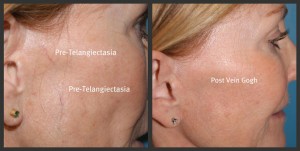And What New Treatments are Available?
By Joseph Magnant, MD, FACS –


Spider veins may also affect other areas of the body including the face, nose, chest and back areas. An effective treatment, the Veingogh Ohmic Thermolysis System uses a hair-thin, insulated probe to thermocoagulate and instantly eliminates unsightly spider veins in these delicate areas, on any skin-type. Treatment of spider veins of the legs is most efficiently and effectively treated with injection sclerotherapy during which a dilute and safe chemical solution is gently injected into the veins thereby causing the veins to close off and fade away with time. Laser sclerotherapy is a more tedious, painful and time intensive technique and has fallen out of favor with most experienced and dedicated vein specialists.
Of the estimated 35 million adults in the U.S. who suffer from superficial venous insufficiency, or venous reflux disease, the majority have symptoms and signs which cause significant pain and disability. Until 2000, the only treatments available for patients with significant saphenous vein insufficiency were compression hose, high ligation or ligation and stripping. The latter two treatments were often considered too invasive for patients with symptoms other than bleeding veins or non-healing leg or ankle venous ulcers. The landscape of venous insufficiency treatment was transformed dramatically by the introduction of endovenous thermal ablation (sealing veins rather than stripping) in 2000. The radiofrequency catheter system was the first system approved by the FDA in 1999 and the LASER system for endovenous ablation received FDA approval in 2001.
Over the past decade, our understanding of venous insufficiency has been greatly improved as endovenous ablation has been applied to patients with advanced stages of venous insufficiency with excellent results. Superficial veins other than the great saphenous vein, such as the small saphenous vein, intersaphenous vein, anterior accessory saphenous vein and perforating veins are now treatable with endovenous ablation. Modern ultrasound evaluation of the lower extremity venous system by experienced vascular technologists can accurately identify which veins are insufficient (leaking) and the severity of reflux. Ultrasound directed sealing of the abnormal veins under local anesthesia has yielded far superior results than vein ligation or stripping. The net result has been relief for millions of patients worldwide and for hundreds of thousands of patients in the USA. Ulcers are being healed in record time, stasis dermatitis changes are being reversed and leg swelling and pain is receding in thousands of patients once thought to be untreatable.
Vein Specialists At Royal Palm Square | 239.694.8346 | weknowveins.com | facebook.com/weknowveins
 Southwest Florida's Health and Wellness Magazine Health and Wellness Articles
Southwest Florida's Health and Wellness Magazine Health and Wellness Articles

